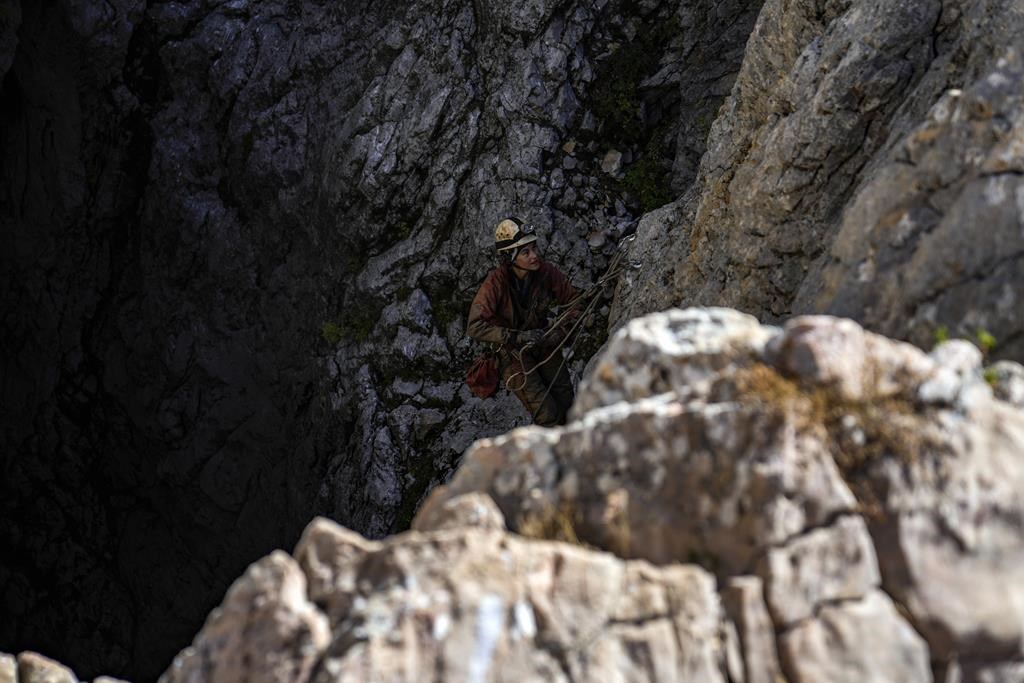Rescuers may soon try to remove a sick American researcher from 3,000 feet down in a Turkish cave

Posted Sep 8, 2023 03:15:57 PM.
TASELI PLATEAU, Turkey (AP) — Rescue crews were waiting for doctors to give the go-ahead Friday for an operation to move out an American researcher who fell ill almost 1,000 meters (more than 3,000 feet) below the entrance of a cave in Turke y, officials said. The effort could last up to 10 days.
Mark Dickey, a 40-year-old experienced caver, suddenly became ill with stomach bleeding during an expedition with a handful of others in the Morca cave in southern Turkey’s Taurus Mountains. Rescuers from across Europe have rushed there to help Dickey and to extract him, including doctors who have treated him inside the cave. The cause of his illness remains unclear.
“The moment we get the go-ahead from the medical team, we will start the evacuation,” Recep Salci, who heads the search and rescue department at Turkey’s disaster relief agency, AFAD, told The Associated Press.
Tulga Sener, a doctor and the medical coordinator of the rescue, said preparations are complete, and that rescue teams had established small “medical camps” at various levels along the shaft as well as a “mini laboratory” to monitor Dickey’s condition.
Doctors would assist him all the way up the cave, Sener told the AP. “If the doctor down there gives approval, the transportation process will begin as soon as possible.”
Rescuers believe Dickey would have to stop and rest frequently at various points along the way up.
Salci said the duration of the rescue would depend on whether Dickey can come out on his own strength with the assistance of rescuers, or — if his condition worsens — on a stretcher.
“If he comes up on a stretcher it could last 10 days. If he is assisted up, then we plan to bring him up in four or five days,” Salci said.
The European Cave Rescue Association said on its website Friday that the cave had been divided into seven sections, with various rescue teams taking responsibility for each of the levels down the cave. Communication lines inside the cave had also been improved, it said.
The cave is one of the deepest in world, according to Federico Catania, a spokesman in Rome for Italy’s National Alpine and Speological Rescue, who said he thought Dickey would need to be carried up on a stretcher.
“The cave is made up of many vertical shafts, so many sections that are extremely vertical with few horizontal sections, where rescuers are setting up temporary camps,” he said.
Giuseppe Conti, a coordinator for the Italian rescue group, told the AP near the entrance to Morca that the “cave is very complex,” and that doctors must stabilize Dickey’s condition in order to allow a rapid rescue.
Doctors have given Dickey IV fluids and 4 liters of blood inside the cave, officials said. Teams comprised of a doctor and three or four others take turns staying with the American at all times.
More than 170 people, including doctors, paramedics and experienced cavers, are involved in the rescue operation. Rescue teams from Bulgaria, Croatia, Hungary, Italy, Poland and Turkey are part of the efforts.
The Italian organization said six of their rescuers, including a doctor and nurse, reached Dickey during the night. The team planned to work to keep him stable for 15-20 hours before being replaced by another team. Small camps set up at different levels inside the cave gave doctors, nurses and technicians a place to rest, the group said.
Turkish authorities made a video message available that showed Dickey standing and moving around on Thursday. While alert and talking, he said he was not “healed on the inside” and needed a lot of help to get out of the cave.
He thanked the caving community and the Turkish government for their efforts to rescue him.
“The caving world is a really tight-knit group, and it’s amazing to see how many people have responded on the surface,” Dickey said in the video. “I do know that the quick response of the Turkish government to get the medical supplies that I need, in my opinion, saved my life. I was very close to the edge.”
The New Jersey-based cave rescue group that Dickey is affiliated with said he had been bleeding and losing fluid from his stomach but had stopped vomiting and ate for the first time in days.
Dickey was described by the European Association of Cave Rescuers as “a highly trained caver and a cave rescuer himself” who is well known as a cave researcher, or speleologist, from his participation in many international expeditions. He is secretary of the association’s medical committee.
The researcher was on an expedition mapping the 1,276-meter (4,186-foot) deep Morca cave system for the Anatolian Speleology Group Association when he ran into trouble about 1,000 meters down, according to Yusuf Ogrenecek of the Speleological Federation of Turkey. He initially became ill on Sept. 2, but it took until the morning of Sept. 3 to notify others who were above ground.
___
Associated Press writers Suzan Fraser in Ankara, Turkey; Robert Badendieck and Ayse Wieting in Istanbul; Mike Catalini in Trenton, New Jersey; Darko Bandic in Zagreb, Croatia; Justin Spike in Budapest, Hungary; Aritz Parra in Madrid; Monika Scislowska in Warsaw, Poland; Patricia Thomas in Rome and Rhonda Shafner in New York contributed to this report.
Mehmet Guzel And Khalil Hamra, The Associated Press








